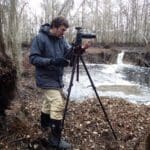

In 2019, the University of Georgia Cooperative Extension organized the first ever Great Georgia Pollinator Census. Citizen scientists from across the state counted pollinators such as butterflies, bees, wasps, and flies, and other insects (everything from praying mantises to beetles). We visited the Cherokee Lake Pollinator Garden in Thomasville during the count.
How healthy is the pollinator population in Georgia?
“You never would have thought nature was so intriguing.” There’s a small crowd around an overturned leaf, looking at what appears to be a shiny bird poop. Two Thomas University students make note of it on their clipboards. The poop they’re looking at is, in actuality, the caterpillar of the giant swallowtail butterfly. It’s on its host plant, the common hop tree (Ptelea trifoliata), a member of the citrus family native to north America.
We’re at the Cherokee Lake Pollinator Garden, a stone’s throw from one of Thomasville’s better known attractions, its Rose Garden. It’s late August, and the place is swarming with insects of all sizes, colors, and shapes. The students, along with volunteers of all ages, are here to take part in the first ever Great Georgia Pollinator Census.
Rob Diaz de Villegas is a senior producer for television at WFSU Public Media, covering outdoors and ecology. After years of producing the music program OutLoud, Rob found himself in a salt marsh with a camera, and found a new professional calling as well. That project, the National Science Foundation funded "In the Grass, On the Reef," spawned the award-winning WFSU Ecology Blog. Now in its tenth year, the Ecology Blog recently wrapped its most ambitious endeavor, the EcoCitizen Project.
Rob is married with two young sons, who make a pretty fantastic adventure squad.





